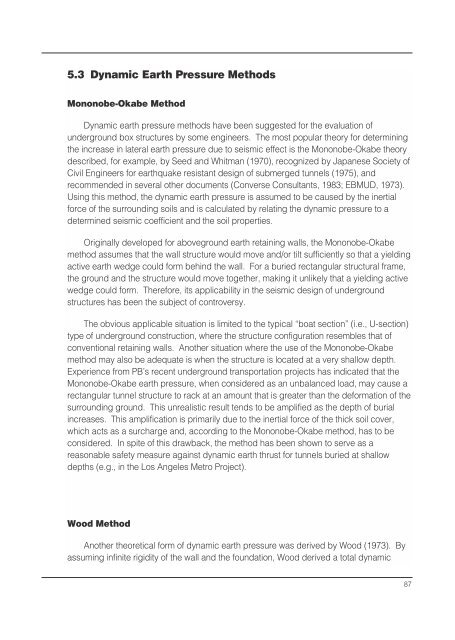Seismic Design of Tunnels - Parsons Brinckerhoff
Seismic Design of Tunnels - Parsons Brinckerhoff
Seismic Design of Tunnels - Parsons Brinckerhoff
You also want an ePaper? Increase the reach of your titles
YUMPU automatically turns print PDFs into web optimized ePapers that Google loves.
5.3 Dynamic Earth Pressure Methods<br />
Mononobe-Okabe Method<br />
Dynamic earth pressure methods have been suggested for the evaluation <strong>of</strong><br />
underground box structures by some engineers. The most popular theory for determining<br />
the increase in lateral earth pressure due to seismic effect is the Mononobe-Okabe theory<br />
described, for example, by Seed and Whitman (1970), recognized by Japanese Society <strong>of</strong><br />
Civil Engineers for earthquake resistant design <strong>of</strong> submerged tunnels (1975), and<br />
recommended in several other documents (Converse Consultants, 1983; EBMUD, 1973).<br />
Using this method, the dynamic earth pressure is assumed to be caused by the inertial<br />
force <strong>of</strong> the surrounding soils and is calculated by relating the dynamic pressure to a<br />
determined seismic coefficient and the soil properties.<br />
Originally developed for aboveground earth retaining walls, the Mononobe-Okabe<br />
method assumes that the wall structure would move and/or tilt sufficiently so that a yielding<br />
active earth wedge could form behind the wall. For a buried rectangular structural frame,<br />
the ground and the structure would move together, making it unlikely that a yielding active<br />
wedge could form. Therefore, its applicability in the seismic design <strong>of</strong> underground<br />
structures has been the subject <strong>of</strong> controversy.<br />
The obvious applicable situation is limited to the typical “boat section” (i.e., U-section)<br />
type <strong>of</strong> underground construction, where the structure configuration resembles that <strong>of</strong><br />
conventional retaining walls. Another situation where the use <strong>of</strong> the Mononobe-Okabe<br />
method may also be adequate is when the structure is located at a very shallow depth.<br />
Experience from PB’s recent underground transportation projects has indicated that the<br />
Mononobe-Okabe earth pressure, when considered as an unbalanced load, may cause a<br />
rectangular tunnel structure to rack at an amount that is greater than the deformation <strong>of</strong> the<br />
surrounding ground. This unrealistic result tends to be amplified as the depth <strong>of</strong> burial<br />
increases. This amplification is primarily due to the inertial force <strong>of</strong> the thick soil cover,<br />
which acts as a surcharge and, according to the Mononobe-Okabe method, has to be<br />
considered. In spite <strong>of</strong> this drawback, the method has been shown to serve as a<br />
reasonable safety measure against dynamic earth thrust for tunnels buried at shallow<br />
depths (e.g., in the Los Angeles Metro Project).<br />
Wood Method<br />
Another theoretical form <strong>of</strong> dynamic earth pressure was derived by Wood (1973). By<br />
assuming infinite rigidity <strong>of</strong> the wall and the foundation, Wood derived a total dynamic<br />
87
















